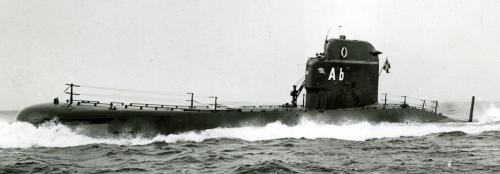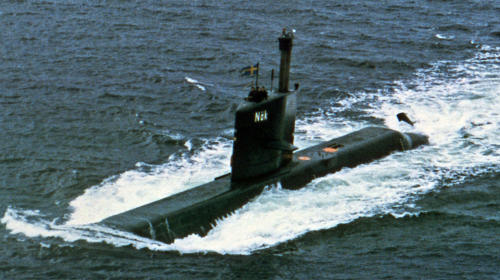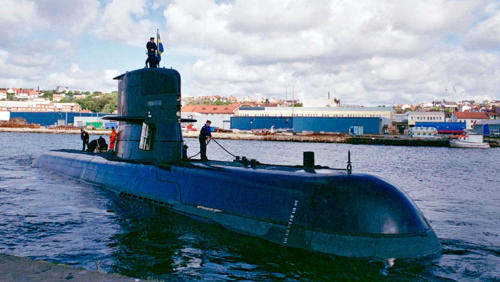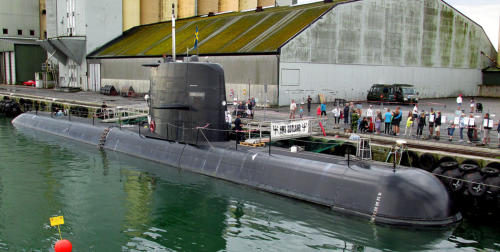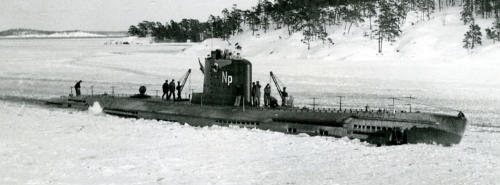

Copyright © Hans Högman 2023-10-02


Ships of the Swedish Navy -
Submarines
List of various types of Swedish
Submarines
•
Early submarines
•
Submarines of the interwar period
•
Submarines, WWII
•
Submarines, Cold War
•
Submarines, post Cold War
Definitions
In the description of the ships, there are some
concepts and terms that may be worth describing.
•
Pennant No., the recognition number that
Swedish warships normally, in peacetime, have
painted on the side of certain types of ships. For
submarines, it is an abbreviation of the
submarine's name. [Hull No. in the US].
•
Delivered refers to the time when the ship was
formally delivered to the Navy from the shipyard.
•
Launched, refers to the time when the ship was
christened and launched.
•
Decommissioned normally refers to the time
when the ship is permanently removed from the
Navy organization.
•
Displacement, expressed in tons, is given with
two values, standard displacement, and
displacement when the ship is fully equipped. If
only one value is given, it refers to standard
displacement. For submarines, displacement is
given in surface mode and submerged mode.
•
Speed is given in knots and refers to the
contracted speed. For submarines, the speed is
given in surface mode and submerged mode.
•
Dimensions, given in meters for length, beam,
and draft. The length may be given in two
dimensions: the waterline and the maximum
overall length. If only one length is given, the
maximum length is referred to. Beam means the
maximum width.
•
Complement, the crew size. It normally refers to
the peacetime crew size.
•
Submarine diving depths indicate the
maximum permitted diving depth in peacetime.
•
ihp = Indicated horsepower (the theoretical
power of a reciprocating engine if it is completely
frictionless)
The abbreviation "HMS" means “Hans Majestäts
Skepp / Hennes Majestäts Skepp” and is used in the
Swedish Navy as a prefix before the ship's name,
such as HMS Visby. However, HMS was not used by
the Swedish Navy until after 1950. For older ships,
i.e. built before 1950, "HM" (His Majesty's) was used
followed by the ship type and name, e.g. HM
Kryssare Tre Kronor.
HSwMS is a sometimes used designation for
military ships from Sweden when traveling outside
Sweden's territorial waters, instead of HMS.
In the UK, the same abbreviation stands for Her
Majesty's Ship or His Majesty's Ship and has been
used in the Royal Navy since the 1660s. The USA
uses the designation USS, United States Ship.
During WW II, from June 23, 1940, Swedish
warships were marked with white transverse
lines on their decks and sides so that they could
be clearly identified as neutral ships and thus
avoid accidental fire from the belligerents.
Ships of the Swedish Navy - 9
Submarines of the Cold War
One of the most important developments in
submarines during World War II was the snorkel. The
snorkel allowed the submarine to recharge its
batteries in submerged mode at periscope depth.
After World War II, the Swedish Navy had a great
need to learn about the rapid technological advances
made by both the Allies and the Germans during the
war. The Swedes knew that Germany had developed
a new, highly advanced submarine model, the XXI.
A XXI class submarine of the German Kriegsmarine, U
3503, had been damaged by Allied aircraft in the
Kattegat and had subsequently entered Swedish
territorial waters at Vinga Sand, west of Gothenburg,
on May 6, 1945. The German crew wanted to repair
the submarine and then depart. This was denied by
the Swedish Navy as they wanted to examine the
new submarine.
This led to the German crew sinking the ship.
However, the submarine was salvaged by the
Swedish Navy by blowing air into the boat. Navy
personnel then managed to start the electric motors
and drive the submarine into shallower waters. It was
then taken into Götaverken’s floating dock in
Gothenburg. The naval administration's specialists
were then able to study and document the
construction, after which it was scrapped. Everything
was examined and documented: the batteries, the
snorkel, the homing torpedoes, the hydraulic system,
the sonar system, the radar, and the radar warning
system.
The German submarine's snorkel system was taken
care of and fitted on trial to the Swedish submarine
HMS Draken and then to the U9. The U 3503 was 76.7
m long with a displacement of 1621/1819 tons and
had a complement of 58 men.
After World War II, a new series of 6 Swedish Hajen
III class submarines were built and entered service
in the late 1950s. These were built partly after
studying the stranded German submarine U 3503.
The advent of the snorkel reduced the need for an
anti-aircraft gun as the batteries could now be
charged in periscope mode. The Hajen class
submarines were 65.8 m long with a displacement of
720 tons. The diving depth was 150 m and the
complement was 37 men. They could be propelled at
16 knots, both in submerged mode and in surface
mode. The subs had 4 torpedo tubes for torpedo
53.3 cm m/54. The submarines in the series were
HMS Hajen, HMS Sälen, HMS Valen, HMS Bävern, HMS
Illern, and HMS Uttern. They were launched between
1954 and 1958 and delivered to the Navy between
1957 and 1960. The submarines were
decommissioned in 1980.
The image shows the Hajen III class submarine HMS
Hajen (Hj) at sea. Launched in 1954, delivered in
1957. Length: 65.8 m. Image: Sjöhistoriska museet,
ID: Fo84959A.
Six submarines of the improved Hajen type (Draken
II class) were produced between 1960-64. However,
these submarines had a new stern, unlike the Hajen
III type submarines, with a large slow-speed 5-bladed
propeller to reduce the typical cavitation noise of the
fast-rotating propellers and a cross rudder. The
submarines were 69.3 m long with a displacement of
770/1125 tons. The diving depth was 150 m and the
complement was 36 men. The subs had 4 torpedo
tubes for the 53.3 cm m/54 torpedo and could carry
8 spare torpedoes.
The submarines in the series were HMS Draken (Dra),
HMS Gripen (Gri), HMS Vargen (Vgn), HMS Delfinen (Del),
HMS Nordkaparen (Nor), and HMS Springaren (Spr).
They were launched between 1960 and 1961 and
delivered to the Navy between 1961 and 1962.
The image shows the submarines HMS Vargen (Vgn)
(left) and HMS Springaren (Spr) (right), both of the
Draken II class. The Vargen was launched in 1960,
delivered in 1961, and the Springaren in 1961 and
1962 respectively. Length: 69.3 m. Image:
Marinmuseum, ID: B33:12.
The Draken II class submarines were rebuilt and
modernized in 1970 - 1971, mainly in terms of fire
control systems. The submarines were
decommissioned in the 1980s.
At the same time, 6 so-called numbered
submarines from World War II were converted into
attack submarines, such as HMS Abborren in the
Coastal Submarine class (see above). It was now
recognized that the best anti-submarine vessel was
another submarine. Then hunter-killer submarines
were needed, a role that the Abborren-type
submarines fulfilled.
Six numbered submarines of the coastal submarine
class were converted during the years 1962 - 1964 to
the hunter-killer submarine class. They were U4 - U9
and underwent extensive rebuilding work, including a
new bow and a new stern. The submarines had the
same stern as the Draken II series with a cross
rudder and silent large propeller. The hydrophone
for detecting enemy submarines was integrated into
the bow.
During this rebuild, these submarines were given
new names that consisted of the names of different
fish species. The names given to each submarine
were HMS Forellen (U4), HMS Abborren (U5), HMS Siken
(U6), HMS Gäddan (U7), HMS Laxen (U8), and HMS
Makrillen (U9). The previous number designations are
in brackets.
The image shows the coastal submarine class
submarine HMS Abborren (Ab), launched in 1943,
delivered in 1944, rebuilt, and modernized in 1962.
Before the rebuilding, she was called HMS U5.
Length: 49.6 m. Image: Maritime History Museum, ID:
Fo97888A.
The submarines were decommissioned in the mid-
1970s.
The Sjöormen class was a series of 5 submarines
built in 1967-1968 at Kockums' shipyard in Malmö
and the Karlskrona shipyard and delivered to the
Navy between 1968 and 1969. The names of the
submarines were HMS Sjöormen (Sor), HMS Sjölejonet
(Sle), HMS Sjöhunden (Shu), HMS Sjöbjörnen (Sbj), and
HMS Sjöhästen (Shä) of the type A11.
The Sjöormen-class submarines were 50.5 m long
(beam 6.1 m) with a displacement of 1,130 tons
(1,210 tons in the submerged mode). The submarine
was thus shorter than previous subs but instead
contained two floors. The speed was 15 knots in
surface mode and 20 knots in submerged mode. The
diving depth was 150 m.
These submarines were arguably Sweden's first real
submarine series with a modern design were both
fast and easy to maneuver, both sideways and at
depth, and had a high battery capacity. The design of
the Sjöormen class was influenced by the German
submarine U3503, of the XXI class, and by the
American experimental submarine USS Albacore.
The teardrop-like hull shape and cross rudder
arrangement are two things that made the Sjöormen
class subs’ maneuverability far superior to that of
earlier Swedish submarines. The Sjöormen class was
one of the first submarine types in the world with a
cross rudder. Although the Draken II class subs were
longer than the Sjöormen class, the latter, with its
two floors, was larger in terms of surface area but
with a complement of only 25 men, compared to the
Draken class’ 37 men. Several functions had been
automated or could be controlled remotely by
hydraulic systems, reducing the need for personnel.
It had very high resistance to depth charges and
naval mines and was much quieter than its
predecessors.
The Sjöormen class subs had 6 torpedo tubes, 4 for
heavy torpedoes with a diameter of 53 cm, and 2
tubes for light torpedoes with a diameter of 40 cm.
The torpedo tubes could also launch F43 mines. For
self-defense on the surface, there were recoilless
rifles m/48 and machine guns m/58. They were also
equipped with a new passive sonar with quadrupled
range.
In the early 1980s, a major modernization was
carried out, which included the
introduction of so-called snorkel
automation. Furthermore, the
combat and fire control system
was upgraded with the digital
SESUB (a combat and fire control
system for submarines) and the
introduction of the advanced
Swedish-built torpedo type 613.
In 1992-1994, two Sjöormen
submarines were modernized,
the Sjölejonet at Muskö naval base and Sjöhunden in
Malmö.
All the Sjöormen class submarines were
decommissioned (sold) in 1997.
The image shows the type A11 Sjöormen class
submarine HMS Sjöormen (Sor). Launched in 1967,
delivered in 1968, modernized in the early 1980s.
Length: 50.5 m. Image: Marinmuseum, ID: D
14969:69.
The upper image shows the diving officer's position
on HMS Sjöormen. Image: Marinmuseum, ID: D
14969:72.
In the late 1960s and early 1970s, the Swedish
Navy had 23 submarines. The submarine fleet
consisted of 6 Hajen class subs, 6 Draken class, 6
Abborren class, and 5 Sjöormen class and these
submarines constituted a very powerful force of high
importance for the country's defense.
The next series of submarines were three A14 type
Näcken class submarines built in 1977-1981 to
replace the Abborren class submarines and were a
further development of the Sjöormen class. The
Näcken submarines were equipped with an
integrated combat and fire control system, which was
the first in the world, and allowed them to use a
digital passive sonar system to evaluate the course,
speed, and distance of targets using only the
bearings of each target.
The three submarines in the class were HMS Näcken
(Näk), HMS Najad (Nad), and HMS Neptune (Nep).
The Näcken class was the first Swedish submarine
with a computerized combat and fire control
system (Näcken Information Processing System, NIBS).
The computer system was also used for steering,
speed, and depth control. The new computer system
together with the eight torpedo tubes and new
advanced torpedoes made it possible to engage
multiple targets simultaneously at great distances.
The Näcken class was designed to carry a large
weapons load, about 15 torpedoes. The submarines
were launched in 1978 - 1979 and delivered to the
Navy in 1980 - 1981.
They were 49,5 m long (beam 5,7 m) with a
displacement of 1.030 tons (1.085 tons in u-mode).
The speed was 12 knots (20 knots in submerged
mode) and the diving depth was 300m. The
complement was only 19 men.
In 1988, the submarine HMS Näcken was fitted with
an air-independent Stirling engine (Stirling MK II),
which increased the underwater operating time from
a few days to several weeks and made Näcken the
world's first operational submarine with conventional
air-independent machinery. The Stirling engine's
oxygen needed for combustion was carried in the
submarine in liquid form. This made propulsion
extremely quiet. To make room for the Stirling
engine, the Näcken was extended by an 8 m long
section. The displacement increased to 1,150 tons
(1,350 in u position) and the complement was
increased to 22 men. The total length was now 57.5
m. The Näcken class submarines were
decommissioned in 1998.
The image shows the A14 type Näcken-class
submarine HMS Näcken (Näk), launched in 1978,
delivered in 1980, and refitted in 1988. Length: 49.5
m (57.5 m from 1988) Image: Marinmuseum, ID:
B33:8.
The Västergötland class was a submarine class
consisting of the 4 submarines HMS Västergötland
(Vgd), HMS Hälsingland (Hgd), HMS Södermanland (Söd),
and HMS Östergötland (Ögd). They were launched
between 1986-1988 and delivered to the Navy
between 1987 and 1990. They were 48.5 m long
(beam 6.1 m) with a displacement of 1,070 tons
(1,150 tons in u-mode). The speed was 11 knots (20
knots in submerged mode) and the diving is depth
300m. The complement is 28 men. They have six 53.3
cm torpedo tubes and three 40 cm torpedo tubes.
The Västergötland class submarines could fire up to
six heavy and six light wire-guided torpedoes
simultaneously at different targets. The
Västergötland class combined the best features of
HMS Sjöormen and HMS Näcken.
The image shows the Västergötland-class submarine
HMS Västergötland (Vgd). Launched in 1986,
delivered in 1987. Length: 48.5 m. Image: Wikipedia.
In 2005, Sweden signed an agreement to sell HMS
Västergötland and HMS Hälsingland to Singapore. This
purchase was completed between 2011 and 2013.
The Stirling Engine
The Stirling engine was a major step forward in the
1990s that meant a major modernization of the
submarine's propulsion and was installed in the
Gotland class subs. Experiments with the Stirling
engine were made by Kockums already with HMS
Näcken, which in 1988 was extended by 8 m and had
a Stirling engine installed. Kockums’ engineers
succeeded in adapting a Stirling engine to a
submarine engine, which revolutionized the
propulsion of submarines with its independence of
air, high efficiency, and almost silent operation. In
other words, the Stirling engine is very quiet and can
work under high external pressure and is therefore
well suited for submarine propulsion. This enabled
the Näcken to stay submerged for several weeks
instead of a few days.
The three Gotland-class submarines, whose
production began in 1990, had the adapted Stirling
engine installed as a power source from the start.
The Gotland-class submarines were delivered to the
Navy in 1999.
However, the Stirling engine is heavy and relatively
expensive to produce, but not in comparison with
other air-independent power sources.
Submarines after the Cold War
HMS Södermanland and HMS Östergötland (see above)
underwent a major refit in 2002-2003 and were
upgraded to a new class, the Södermanland class.
They were now equipped with Stirling engines,
which significantly improved the submarines'
endurance. The length was increased to 60.4 m and
the displacement to 1,400 tons.
The submarines were also adapted to handle
international missions with operations in both hot
and saltier waters. The Södermanland class
submarines have greater anti-submarine warfare
capabilities than previous classes as they are
equipped with a new anti-submarine warfare
torpedo.
The image shows the Västergötland class submarine
HMS Södermanland (Söd). Launched in 1988,
delivered in 1989. Length: 48.5 m. Rebuilt 2002-2003.
New length 60.4 m. New class: Södermanland class.
Photo in 2014. Image: Marinmuseum, ID: MM.V
10027.
HMS Södermanland was upgraded in 2010 with,
among other things, a new combat and fire control
system (SESUB 960), a new navigation system and
new communication systems. HMS Östergötland is
currently disarmed (2021).
The Gotland class (of type A19) is a Swedish
submarine series comprising three submarines,
HMS Gotland (Gtd), HMS Halland (Hnd), and HMS
Uppland (Upd) delivered in 1999. They are essentially
based on the Västergötland class submarines but
with several improvements. The submarine type has
two diesel engines and two Stirling engines, which
provide air independence and double the endurance
compared to previous submarine types. The Gotland
class submarines are equipped with both light
torpedoes for self-defense against other submarines
and heavy torpedoes for operations against surface
ships. In other words, the Gotland series was
equipped with Stirling engines from the start.
They were launched between 1995 and 1996 and
delivered to the Navy in 1999. They are 60.4 m long
(beam 6.2 m) with a displacement of 1,380 tons
(1,490 tons submerged). They have a speed of 15
knots (20 knots in submerged mode) and a diving
depth of 300 m. The complement is 25 men. They
have four 53.3 cm torpedo tubes and two 40 cm
torpedo tubes. For passive reconnaissance, the subs
are equipped with circular sonar and FAS ("Flank
Array Sonar").
All Gotland class submarines and HMS
Södermanland received a new SESUB960 command
and control system in 2010-2013.
HMS Gotland made a high-profile visit to the US in
2005-2007 when she exercised with the US Navy's
anti-submarine warfare units off the coast of
California. Opponents in the exercises had difficulty
locating the Swedish submarine.
The image shows the Gotland-class (A19) submarine
HMS Gotland (Gtd). Launched in 1995, delivered in
1999. Length: 60.4 m. Refitted in 2016-2018. New
length 62.4 m. Photo in Ystad in August 2015. Image:
Wikipedia.
In 2010 and 2011, HMS Halland was the first of the
Gotland-class submarines to be partially mid-life
modified, including new systems for command
(SESUB 960), navigation, and communications.
During 2014 - 2015, HMS Halland underwent further
modernization.
Between 2016 and June 2018, HMS Gotland was
modified at the Karlskrona shipyard with, among
other things, new Stirling engines, new combat
management systems, new sonar, a diving bell, and
the periscope has been changed to an optronic mast.
The submarine was divided and extended by about 2
m to 62.7 m. The new displacement in surface mode
is 1,580 tons. In May 2020, HMS Gotland was handed
over to the Swedish Armed Forces.
Between 2018 and 2019, HMS Uppland was also
modified. The hull was extended with a new section
for ship technical equipment and by 2 meters to 62
meters. Furthermore, new sensors and a new
management system were added to the submarine.
In March 2022, the Swedish Armed Forces
announced that all Gotland-class submarines and
HMS Södermanland will undergo mid-life
modifications to maintain operational capability.



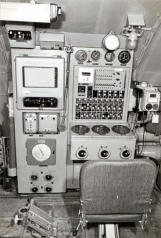

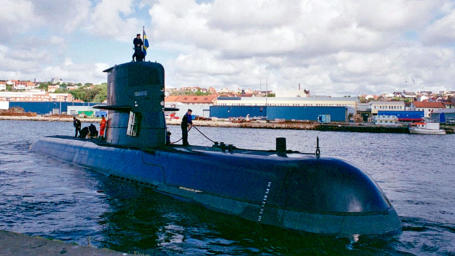
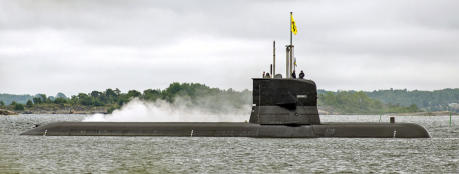
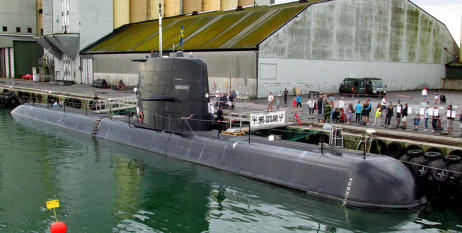
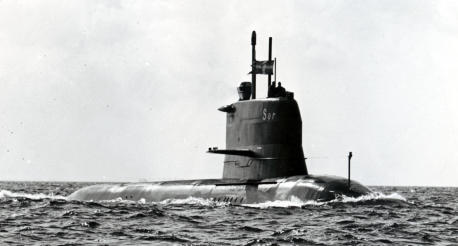
The Blekinge class or "Next Generation Submarine"
(NGS) is a new class of submarine being built by Saab
Kockums AB for the Swedish Armed Forces. The
submarine project is known as A26.
The Bleking-class submarines are an improved
version of the Gotland-class, with a displacement of
about 1,800 tons (1,925 tons in submerged mode)
and a complement of 17-35 men (max 35) and will be
the Swedish Navy's spearhead under the surface
after delivery.
They are 66.1 m long (beam 6.71 m). The speed is 12
knots (20 knots in submerged mode) and dive depth
> 200 m. Range: 45-day mission.
The submarine has 3 diesel-electric and 3 Stirling
engines and is equipped with four 53 cm torpedo
tubes and 1 variable tube - FPL (Flexible Payload Lock)
of 6m x 1.5m that can be used to let divers in and out,
mini-craft and for example naval mines deep down in
the water. Armament: Torpedoes, naval mines, AUV
(Autonomous Underwater Vehicle), ROV (Remotely
operated underwater vehicle), and MSF (Maritime
Special Forces).
The submarine class will have a very strong hull that
protects against shocks and underwater explosions in
the form of detonating naval mines, torpedoes, depth
charges, etc.
In January 2019, the two ordered A26 submarines
were named HMS Blekinge and HMS Skåne. HMS
Blekinge will be delivered in 2028 and HMS Skåne in
2029.
The first A26 sub was scheduled to be delivered in
2022 and the second in 2023. In August 2021, Saab
Kockums announced that the submarines were
delayed and would now not be delivered until 2028
and 2029.

The Swedish Submarine Force
Swedish submarines began to be manufactured for
the Swedish Navy in 1869. Over the past century and
a half, some 20 different submarine series have been
designed in Sweden and more than 70 submarines
of various sizes and types have been built in the
country, more than half of them at the Kockums
shipyard in Malmö. To increase the safety of the
submarine weapon, the navy has had a submarine
rescue vessel (URF - UbåtsRäddningsFarkost) since the
1970s.
The Swedish submarine force was formed in 1904
when HMS Hajen (The Shark) was delivered as the first
submarine. The unit for submarine operations was
the First Submarine Flotilla (1. ubflj). The
submarine flotilla was part of the coastal fleet and
was subordinate to it until 1998.
The Swedish inventor and industrialist Thorsten
Nordenfelt (1842 - 1920) was an important and
significant submarine pioneer in Sweden. After a stay
in Liverpool in 1881, he was inspired to start
designing and building submarines.
Despite technological developments in submarine
functionality, the early submarine was a
submersible (Swe: Dykbåt). That is, a surface vessel
that, when an enemy was sighted, dived below the
surface and then fired a torpedo. If the threat of a
counterattack was low, torpedoes could also be fired
from the surface mode. The attack could also be
carried out with a cannon on the surface mode. In
addition, periscopes were not very well developed at
that time. Reconnaissance was carried out only with
binoculars, which limited the range of vision and
meant short detection distances.
Submarines are self-supporting and capable of
prolonged independent operation at sea which
distinguishes them from submersibles.
The early submarines were powered by an internal
combustion engine in surface mode, combined
with battery power in submerged mode. However,
battery capacity was limited, as was the availability of
oxygen on board. Initially, gasoline engines were used,
but later more reliable and fire-safe diesel engines
were used.
During both world wars, submarines were still
basically submersibles, but with a greater
operational range and longer endurance in
submerged mode.
Since the 1990s, Swedish submarines have been
using Stirling engines to increase their endurance in
submarine mode. A Swedish submarine can
therefore stay underwater for 30 days.
The abbreviation 'HMS' was not used by the Swedish
Navy until after 1950. Previously, "HM" (His Majesty's)
was used, followed by the ship type and name.
However, in this article, I have used HMS for all
submarines regardless of when they were in service.
Early submarines
Sweden's first actual submarine was HMS Hajen,
designed by the Swedish ship designer Carl Richson
(1857 - 1925). He had a background in the American
defense industry and had experience in submarine
manufacturing. The Hajen was based on an
American 'Holland-type' design.
HMS Hajen was built at Galärvarvet shipyard in
Stockholm and delivered to the Swedish Navy in
1904. It had a displacement of 107 tons, was 21.6 m
long, had a periscope and a complement of 8 men.
The submarine had a single hull and its diving depth
was limited to 30 m. From 1909, the submarine was
called Undervattensbåten N:o 1. During 1915 - 1916,
the submarine was rebuilt and, among other things,
it was extended to 23.3 m.
The boat was scrapped in 1922 and today it is a
museum submarine at
the Naval Museum,
Karlskrona.
The image on the right
shows the submarine
HMS Hajen, launched in
1904. Image: Wikipedia.
The Hajen was considered
a successful design and
submarines belonged to the future, so in 1907 the
Royal Naval Administration ordered a new submarine
from the Italian shipyard Fiat-San Giorgio. It was
named HMS Hvalen and was launched in 1909.
Much larger than the Hajen, the Hvalen was 42.5 m
long, had a double hull, was powered by three 12-
cylinder gasoline engines, had a complement of 17
and could dive to a depth of 30 m.
The Hvalen was handed over to the Swedish Navy in
Italy in July 1909 and after a long journey home
under her own power, she was moored at the
Stockholm Naval Station on Skeppsholmen in
October.
The image to
the right shows
the submarine
HMS Hvalen,
launched in
1909. The
photo was
taken outside Nynäshamn in 1909. Image: Maritime
History Museum, ID: Fo88551A
In 1909, 3 submarines were delivered to the Navy
based on the experience of HMS Hajen. They were
similar in size to the Hajen and were named
Undervattensbåten N:r 2 - Undervattensbåten N:r 4
(Submarine No. 2 - Submarine No. 4). Length 26.8 m.
Diving depth: 30 m. New were the three-tank
systems, which meant that ballast water could be
taken into three different tanks. They were
designated 2nd class submarines. During 1914 -
1915 two more submarines of this class were built.
Instead of numbers, they were named HMS Laxen
and HMS Gäddan.
The image shows the submarine
Undervattensbåten N:r 4 (Submarine No. 4),
launched in 1909. The photo was taken in 1911.
Image: War Archives, KrA.
The next class of submarines was the Svärdfisken
class. They were 1st class double-hulled submarines.
Two submarines were built, HMS Svärdfisken and HMS
Tumlaren and both were delivered in 1914. They were
the first double hull submarines where the ballast
tanks were placed between the outer hull and the
pressure hull. The Svärdfisken class submarines were
larger and more spacious than the Hvalen. They were
45.5 m long with a displacement of 252 tons and had
a complement of 21 men. The subs were built by
Kockums shipyard in Malmö under a license from
Italy. They were armed with two forward 45 cm
torpedo tubes (M/1904-12) and were the first
submarines to be equipped with a deck gun.
HMS Delfinen was a 2nd class submarine built by
Bergsunds Mechanical Workshop and launched at
Finnboda slipway in Stockholm in 1914. She had the
same armament as the Svärdfisken class submarines
but was basically a different design. It was a Swedish
design with a single hull. The Delfinen was 42.5 m
long with a displacement of 260 tons and had a
complement of 21 men.
In 1917, two Abborren class submarines were
delivered. They were HMS Abborren and HMS Braxen.
They were, like the Gäddan and Laxen in principle
copies of the number series Undervattensbåten N:r 1
- Nr:4. However, the Abborren class submarines were
slightly longer, 31 m, and with a displacement of 174
tons. Its diving depth was 50 m.
When World War I broke out in 1914, funds were
granted to build new 1st Class submarines. However,
these were not delivered until 1920, i.e. after the end
of the war. The delivery consisted of three
submarines and these were based on the earlier
Hajen class submarines. They were HMS Hajen, HMS
Sälen and HMS Valrossen. These subs were of the
Hajen II class and were 54 m long with a diving
depth of 50 m. Being larger, they had 4 bow torpedo
tubes and could carry 8 torpedoes and had a 57 mm
deck gun. The speed 15.5 knots, in submerged mode
9 knots.
The image shows the Hajen II class submarine HMS
Hajen (Hj), delivered to the Swedish Navy in 1920.
The photo was taken in Gothenburg in 1941. Image:
Wikipedia.
Subs - Interwar period
After WWI, 3 double-hulled submarines were built in
Sweden under license from AG Weser in Germany.
These submarines were designated the Bävern class
and consisted of HMS Bävern, HMS Illern, and HMS
Uttern. The subs were delivered in 1921. They were
slightly larger than the Hajen II class submarines, 57 m
long, but had the same armament. The diving depth
was 60 m.
The image shows the Bävern class submarine HMS
Uttern (U), delivered to the Navy in 1921. Image:
Naval Museum, ID: D 14983:6.
HMS Valen was Sweden's first mine-laying
submarine. It was based on the design of the Bävern
class but was just over a meter wider. The Valen was
launched and delivered to the Navy in 1925. She was
57.1 m long and had 10 mine tubes with space for a
total of 20 mines. Otherwise, it had the same
armament as the Bävern class.
The Draken class submarines were three in
number. They were built between 1926 and 1930.
The Draken class was a further development of the
Bävern class. However, the Draken class was
significantly larger and more heavily armed than the
Bävern class. The Draken class submarines were 66.2
m long with a displacement of 667/850 tons. The
diving depth was 60 m.
They were equipped with 4 torpedo tubes for 53 cm
torpedoes m/26 and had a 10.5 cm deck gun m/25
and a 25 mm machine gun m/22.
The most famous submarine in this class is probably
HMS Ulven which hit a mine and sank at Stora Pölsan
outside Marstrand on the Swedish west coast on
April 15, 1943, i.e. during WWII. The entire crew of 33
men perished.
HMS Ulven joined the Draken-class submarines HMS
Gripen and HMS Draken in the Gothenburg Squadron.
The image shows HMS Ulven (Uv) of the Draken
class at sea in the early 1930s, launched in 1930 and
delivered to the Navy in 1931. Note the fishing net
cutter at the fore. Image: Marinmuseum, ID: D
11085:1:24.
The Delfinen II class submarines were also three in
number. The submarines were built at Kockums
Mechanical Workshop in Malmö. The submarines
were delivered in 1936-1937. The Delfinen II class
submarines were 63.1 m long with a displacement of
540/720 tons. The diving depth was 90 m. The
submarines are classified as minelaying submarines
as they could be used to lay mines. The submarines
were equipped with escape hatches where the crew,
in an emergency, could ascend freely to the surface.
HMS Springaren (Sp) was launched in 1935 and
delivered to the Navy in 1937. It was the first
submarine in Swedish service to be named
Springaren.
The Delfinen II class also included the submarines
HMS Delfinen and HMS Nordkaparen.
The image shows the Delfinen II class submarine
HMS Springaren (Sp) at sea in 1940. Image:
Maritime History Museum, ID: Fo89077AB.
Submarines of WWII
In the second half of the 1930s, Kockums’ submarine
production was extensive, including the Delfinen II
class, which was to be used for mine laying missions.
Submarines of the Sjölejonet class are a series of 9
Swedish submarines built between 1936 and 1941
and were purely attack submarines and therefore
had more torpedo tubes and more powerful engines
for increased range compared to the Delfinen II class.
However, until the end of the Second World War, the
Swedish submarines were considered submersibles.
In 1943, 3 Neptune-class submarines were delivered.
Between 1941 and 1944, 9 Coastal class submarines
were built. These boats had no christening names
but only a number series, U1 - U9.
The Sjölejonet class was a series of 9 Swedish
submarines built between 1936 and 1941. The class
included the submarines HMS Sjölejonet, HMS
Sjöbjörnen, HMS Sjöhunden, HMS Svärdfisken, HMS
Tumlaren, HMS Dykaren, HMS Sjöhästen, HMS
Sjöormen, and HMS Sjöborren. These submarines
were a further development of the Delfinen II class
submarines. However, they were equipped with
more powerful torpedoes and more modern anti-
aircraft guns. The boats were developed in a very
short time and were launched between 1936 and
1941 and delivered to the Navy between 1938 and
1942. The submarines had a length of 64.2 m with a
displacement of 580/720 tons. They had a
complement of 32 men and a diving depth of 100
meters. The two 40 mm anti-aircraft guns m/32 were
submersible in airtight wells. There were also two
machine guns.
The Sjölejonet submarines were pure attack
submarines and therefore had more torpedo tubes
and more powerful engines for increased range
compared to the Delfinen II class. The Swedish Navy
now had modern and powerful submarines.
When the submarines were rebuilt in the late 1940s,
they were fitted with a snorkel and a new tower.
The submarines were decommissioned in the late
1950s and early 1960s.
The image shows the submarine HMS Sjölejonet (Sl)
of the Sjölejonet class. Launched in 1936, delivered in
1938, length 64 m. Image: Naval Museum, ID: D
11085:1:14.
During World War II, a series of 9 smaller
submarines were built that were a completely
Swedish design, ie the so-called "number
submarines". The length was 49.6 m and the
displacement was 367 tons with a complement of 26
men. The diving depth was 100 m. They were
delivered to the Navy between 1942 and 1944 and,
given their size and intended tasks, were called
coastal submarines (Swe: Kustubåtar). These
submarines switched from the tried and tested
method of riveting the hulls to the use of fully
welded pressure hulls. The designations for these
submarines were U1, U2, U3, U4, U5, U6, U7, U8, and
U9. They had 4 torpedo tubes and a 40 mm anti-
aircraft gun m/40.
The U3 was modernized at the Kockums shipyard in
Malmö between 1952 and 1953 and was fitted with a
snorkel and a host of other improvements.
The submarines U4-U9 were rebuilt between 1962
and 1964 as Abborren II class submarines, whereby
the entire stern was replaced with a new one
containing an electric motor for propulsion and a
torpedo magazine for anti-submarine warfare
torpedoes in ballast tank three. In connection with
the rebuilding, these submarines were given new
names, which were the names of different fish
species. The U3 is now a museum ship at the House
of Technology and Shipping in Malmö.
The image shows the coastal submarine class
submarine HMS U3 around 1945. Launched in 1942,
delivered in 1943, length 49.6 m. Image: Wikipedia.
To replace the now 15-year-old mine-laying
submarine HMS Valen and to complement the 3
Delfinen-class mine-laying submarines, 3 Neptune-
class mine-laying submarines were built during the
war years. They were HMS Neptune, HMS Najad, and
HMS Näcken and all these were built in 1942 and
delivered to the Navy in 1943. These submarines
were largely based on the Delfinen class type.
However, the Neptune class submarines had 5
torpedo tubes and carried 20 torpedoes. The length
of the submarines was 62.6 m with a displacement
of 540/720 tons. The diving depth was 100 m and
the complement consisted of 29 men. The Neptune
submarines were rebuilt in 1951 with a new tower
and snorkel. The submarines were decommissioned
in 1966.
The image shows the Neptune class submarine HMS
Neptune (Np) at sea in winter in the archipelago.
Launched in 1942, delivered in 1943, length 62.6 m.
Image: Maritime History Museum, ID: Fo88698AB.
To reduce casualties and protect shipping from
submarine attacks during the war, the British began
using convoys of ships, with warships protecting
merchant ships. The rapid technological
development of radar, sonar (hydrophones), sonar
buoys, and signals intelligence greatly improved the
ability for anti-submarine warfare. These new
sensors began to be installed on all warships and
aircraft. At this time, submarines had to surface to
recharge their batteries, usually at night. The
development of the snorkel later allowed
submarines to charge their batteries in submerged
mode at periscope depth, thus reducing the risk of
detection.
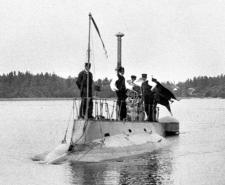









The Blekinge class or "Next Generation Submarine"
(NGS) is a new class of submarine being built by Saab
Kockums AB for the Swedish Armed Forces. The
submarine project is known as A26.
The Bleking-class submarines are an improved
version of the Gotland-class, with a displacement of
about 1,800 tons (1,925 tons in submerged mode)
and a complement of 17-35 men (max 35) and will be
the Swedish Navy's spearhead under the surface
after delivery.
They are 66.1 m long (beam 6.71 m). The speed is 12
knots (20 knots in submerged mode) and dive depth
> 200 m. Range: 45-day mission.
The submarine has 3 diesel-electric and 3 Stirling
engines and is equipped with four 53 cm torpedo
tubes and 1 variable tube - FPL (Flexible Payload Lock)
of 6m x 1.5m that can be used to let divers in and out,
mini-craft and for example naval mines deep down in
the water. Armament: Torpedoes, naval mines, AUV
(Autonomous Underwater Vehicle), ROV (Remotely
operated underwater vehicle), and MSF (Maritime
Special Forces).
The submarine class will have a very strong hull that
protects against shocks and underwater explosions in
the form of detonating naval mines, torpedoes, depth
charges, etc.
In January 2019, the two ordered A26 submarines
were named HMS Blekinge and HMS Skåne. HMS
Blekinge will be delivered in 2028 and HMS Skåne in
2029.
The first A26 sub was scheduled to be delivered in
2022 and the second in 2023. In August 2021, Saab
Kockums announced that the submarines were
delayed and will now not be delivered until 2028 and
2029.









